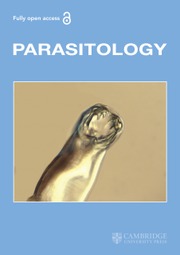Crossref Citations
This article has been cited by the following publications. This list is generated based on data provided by
Crossref.
LITTLEWOOD, D. T. J.
2011.
Systematics as a cornerstone of parasitology: overview and preface.
Parasitology,
Vol. 138,
Issue. 13,
p.
1633.
Barbrook, Adrian C.
Dorrell, Richard G.
Burrows, Jennifer
Plenderleith, Lindsey J.
Nisbet, R. Ellen R.
and
Howe, Christopher J.
2012.
Polyuridylylation and processing of transcripts from multiple gene minicircles in chloroplasts of the dinoflagellate Amphidinium carterae.
Plant Molecular Biology,
Vol. 79,
Issue. 4-5,
p.
347.
Mast, F. D.
Rachubinski, R. A.
and
Dacks, J. B.
2012.
Emergent Complexity in Myosin V-Based Organelle Inheritance.
Molecular Biology and Evolution,
Vol. 29,
Issue. 3,
p.
975.
Solter, Leellen F.
Becnel, James J.
and
Vávra, Jiri
2012.
Manual of Techniques in Invertebrate Pathology.
p.
329.
East, Michael P.
Bowzard, J.Bradford
Dacks, Joel B.
and
Kahn, Richard A.
2012.
ELMO Domains, Evolutionary and Functional Characterization of a Novel GTPase-activating Protein (GAP) Domain for Arf Protein Family GTPases.
Journal of Biological Chemistry,
Vol. 287,
Issue. 47,
p.
39538.
Kashiyama, Yuichiro
Yokoyama, Akiko
Kinoshita, Yusuke
Shoji, Sunao
Miyashiya, Hideaki
Shiratori, Takashi
Suga, Hisami
Ishikawa, Kanako
Ishikawa, Akira
Inouye, Isao
Ishida, Ken-ichiro
Fujinuma, Daiki
Aoki, Keisuke
Kobayashi, Masami
Nomoto, Shinya
Mizoguchi, Tadashi
and
Tamiaki, Hitoshi
2012.
Ubiquity and quantitative significance of detoxification catabolism of chlorophyll associated with protistan herbivory.
Proceedings of the National Academy of Sciences,
Vol. 109,
Issue. 43,
p.
17328.
Marron, Alan O.
Akam, Michael
Walker, Giselle
and
Stiller, John W.
2012.
Nitrile Hydratase Genes Are Present in Multiple Eukaryotic Supergroups.
PLoS ONE,
Vol. 7,
Issue. 4,
p.
e32867.
Mulder, Christian
Boit, Alice
Mori, Shigeta
Vonk, J. Arie
Dyer, Scott D.
Faggiano, Leslie
Geisen, Stefan
González, Angélica L.
Kaspari, Michael
Lavorel, Sandra
Marquet, Pablo A.
Rossberg, Axel G.
Sterner, Robert W.
Voigt, Winfried
and
Wall, Diana H.
2012.
Global Change in Multispecies Systems Part 1.
Vol. 46,
Issue. ,
p.
1.
Elias, Marek
Brighouse, Andrew
Castello, Carme Gabernet
Field, Mark C.
and
Dacks, Joel B.
2012.
Sculpting the endomembrane system in deep time: High resolution phylogenetics of Rab GTPases.
Journal of Cell Science,
Kramer, Susanne
Marnef, Aline
Standart, Nancy
and
Carrington, Mark
2012.
Inhibition of mRNA maturation in trypanosomes causes the formation of novel foci at the nuclear periphery containing cytoplasmic regulators of mRNA fate.
Journal of Cell Science,
Butterfield, Erin R.
Howe, Christopher J.
and
Nisbet, R. Ellen R.
2013.
An Analysis of Dinoflagellate Metabolism Using EST Data.
Protist,
Vol. 164,
Issue. 2,
p.
218.
Ptáčková, Eliška
Kostygov, Alexei Yu.
Chistyakova, Lyudmila V.
Falteisek, Lukáš
Frolov, Alexander O.
Patterson, David J.
Walker, Giselle
and
Cepicka, Ivan
2013.
Evolution of Archamoebae: Morphological and Molecular Evidence for Pelobionts Including Rhizomastix, Entamoeba, Iodamoeba, and Endolimax.
Protist,
Vol. 164,
Issue. 3,
p.
380.
Lipowicz, Bartosz
Hanekop, Nils
Schmitt, Lutz
and
Proksch, Peter
2013.
An Aeroplysinin-1 Specific Nitrile Hydratase Isolated from the Marine Sponge Aplysina cavernicola.
Marine Drugs,
Vol. 11,
Issue. 8,
p.
3046.
Cantacessi, Cinzia
Seddon, Jennifer M.
Miller, Terrence L.
Leow, Chiuan Yee
Thomas, Laëtitia
Mason, Lyndel
Willis, Charlene
Walker, Giselle
Loukas, Alex
Gasser, Robin B.
Jones, Malcolm K.
and
Hofmann, Andreas
2013.
A genome-wide analysis of annexins from parasitic organisms and their vectors.
Scientific Reports,
Vol. 3,
Issue. 1,
Dorrell, Richard G.
Butterfield, Erin R.
Nisbet, R. Ellen R.
and
Howe, Christopher J.
2013.
Evolution: Unveiling Early Alveolates.
Current Biology,
Vol. 23,
Issue. 24,
p.
R1093.
Spycher, Cornelia
Herman, Emily K.
Morf, Laura
Qi, Weihong
Rehrauer, Hubert
Aquino Fournier, Catharine
Dacks, Joel B.
and
Hehl, Adrian B.
2013.
An ER‐directed transcriptional response to unfolded protein stress in the absence of conserved sensor‐transducer proteins in Giardia lamblia.
Molecular Microbiology,
Vol. 88,
Issue. 4,
p.
754.
Goodman, Christopher D
and
McFadden, Geoffrey I
2013.
Targeting apicoplasts in malaria parasites.
Expert Opinion on Therapeutic Targets,
Vol. 17,
Issue. 2,
p.
167.
Marron, Alan O.
Alston, Mark J.
Heavens, Darren
Akam, Michael
Caccamo, Mario
Holland, Peter W. H.
and
Walker, Giselle
2013.
A family of diatom-like silicon transporters in the siliceous loricate choanoflagellates.
Proceedings of the Royal Society B: Biological Sciences,
Vol. 280,
Issue. 1756,
p.
20122543.
Kirk, N. L.
Thornhill, D. J.
Kemp, D. W.
Fitt, W. K.
and
Santos, S. R.
2013.
Ubiquitous associations and a peak fall prevalence between apicomplexan symbionts and reef corals in Florida and the Bahamas.
Coral Reefs,
Vol. 32,
Issue. 3,
p.
847.
Brown, Matthew W.
Sharpe, Susan C.
Silberman, Jeffrey D.
Heiss, Aaron A.
Lang, B. Franz
Simpson, Alastair G. B.
and
Roger, Andrew J.
2013.
Phylogenomics demonstrates that breviate flagellates are related to opisthokonts and apusomonads.
Proceedings of the Royal Society B: Biological Sciences,
Vol. 280,
Issue. 1769,
p.
20131755.

